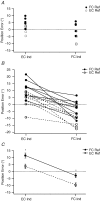Effects of muscle conditioning on position sense at the human forearm during loading or fatigue of elbow flexors and the role of the sense of effort
- PMID: 17255167
- PMCID: PMC2075550
- DOI: 10.1113/jphysiol.2006.125161
Effects of muscle conditioning on position sense at the human forearm during loading or fatigue of elbow flexors and the role of the sense of effort
Abstract
In a forearm position-matching task in the horizontal plane, when one (reference) arm is conditioned by contraction and length changes, subjects make systematic errors in the placement of their other, indicator arm. Here we describe experiments that demonstrate the importance not just of conditioning the reference arm, but of the indicator arm as well. Total errors from muscle conditioning represented up to a quarter of the angular range available to subjects. The sizes of the observed effects have led us to repeat other, previously reported experiments. In a matching task in the vertical plane, when muscles of both arms were conditioned identically, if the subject supported their arms themselves, or when the arms were loaded by the addition of weights, the loading did not introduce new position errors. To test the effect of exercise, subjects' elbow flexors were exercised eccentrically or concentrically by asking them to lower or raise a set of weights using forearm muscles. The exercise produced 25-30% decreases in maximum voluntary contraction strength of elbow flexors and this led to significant position-matching errors. The directions and magnitudes of the errors were similar after the two forms of exercise and indicated that subjects perceived their exercised muscles to be longer than they actually were. To conclude, the new data from loading the arm are not consistent with the idea that the sense of effort accompanying support of a load, provides positional information in any simple way. Our current working hypothesis is that when muscles are active, position-sense involves operation of a forward internal model. Loading the arm produces predictable changes in motor output and afferent feedback whereas changes after exercise are unpredictable. This difference leads to exercise-dependent errors.
Figures




References
-
- Allen TJ, Proske U. Effect of muscle fatigue on the sense of limb position and movement. Exp Brain Res. 2006;170:30–38. - PubMed
-
- Capaday C, Cooke JD. The effects of muscle vibration on the attainment of intended final position during voluntary human arm movements. Exp Brain Res. 1981;42:228–230. - PubMed
-
- Collins DF, Refshauge KM, Todd G, Gandevia SC. Cutaneous receptors contribute to kinesthesia at the index finger, elbow, and knee. J Neurophysiol. 2005;94:1699–1706. - PubMed
-
- Cullen KE. Sensory signals during active versus passive movement. Curr Opin Neurobiol. 2004;14:698–706. - PubMed
Publication types
MeSH terms
LinkOut - more resources
Full Text Sources
Medical

